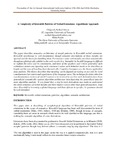| dc.description.abstract | The paper describes semantics architecture of morph pairwise in Kiswahili verbal extensions.
Kiswahili morphology is well documented, though semantic descriptions of these morphs are
ignored and the theory for handling them. For instance some verb morphs are silent semantically
though morphologically exhibit i:e the verb wa-sh-i-k-a ‘burnable’ in Swahili language is difficult
to explain the sense and its constituents, and most of the speakers and writers generalize such
verbalizers senses and ignoring each constuent’s sense such behavior needs to be described at
length and the way of handling them theoretically. Cognitive Grammar was the theory applied for
data analysis. The theory describes that meaning can be figured out basing on not only by word
constituencies but context and experiences of the language users. The technique for data collection
was documentary reviews of which 5 sources were reviewed to see how such derivations have been
generalized semantically against algorithm architecture then depicting the generalized data for
more algorithm analysis. It was found that, a step by stem derivations may make us understand
the silent semantics of verbal morphs and their implicit senses other than generalizing them. Thus
since Kiswahili is becoming a global language and East African in specific, its grammar should
be well identified. | en_US |

